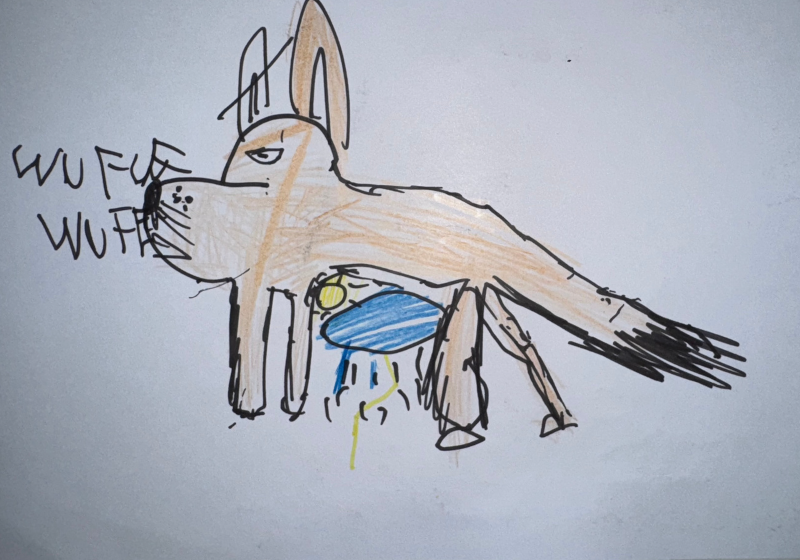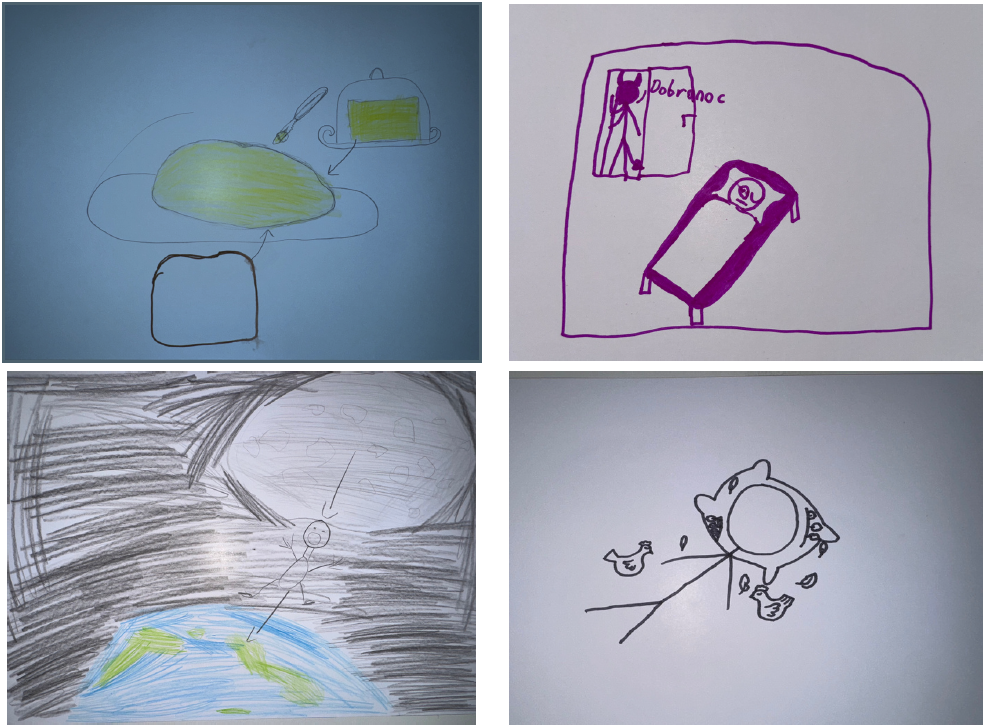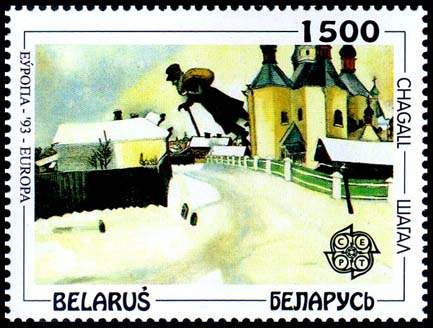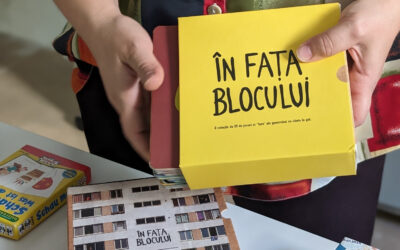Proverbidioms
Key elements of all languages, proverbs and idioms, largely or exclusively, have a
figurative meaning rather than making any literal sense. By drawing inspiration from
great painters, this activity intends to help young heritage speakers to familiarise
themselves with them by painting or drawing them to the letter.
Proverbidioms
The activity helps to dive into the world of idioms by turning quirky expressions into creative artworks. Sharing the artwork with the group also builds confidence and encourages participants to talk about language in a playful way.
90 min
2-6 years old (adaptable for children up to age 12, see below)
Language Skills
B1 or above
Up to 20 participants
This activity helps participants understand idioms by turning them into creative drawings. While having fun, they learn the meaning behind unusual expressions, explore how language works, and practise using their imagination.
Painting or drawing utensils, drawing or colouring paper, a list of proverbs or idioms.

Languages Available
Step-by-step Guide
1. Preparation:
Write the idioms on small strips of paper and then either distribute them on the table so that participants can read the text or hide in empty plastic containers from ‘surprise eggs’. Participants then can pick one randomly.
Among the Polish idioms used were the following: ‘pogoda pod psem’, literally ‘the weather under a dog’ (see the preceding page), which means ‘rotten, gloomy weather’, when it is, for example, ‘raining cats and dogs’.
Another one was ‘bulka z maslem’ – ‘a bun with butter’, a phrase used to say that something is easy, a piece of cake.
A third one, ‘gwóźdź do trumny’, also exists in English: to put a final nail in the coffin refers to a last event or action that seals the outcome and makes it irreversible.
Yet another one, ‘gdzie diabeł mówi dobranoc’, designates a place in the middle of nowhere, where, in Polish, ‘the devil says goodnight’.
2. Welcome the participants:
Welcome everyone to the workshop and explain its nature and purpose. If the participants don’t know each other yet, you may want to organise a short icebreaker during which they have an opportunity to present themselves and get to know each other. As a warm-up excise, use Polish tongue twisters.
3. Introducing proverbs and idioms in the history of painting:
The title of this learning module, based on Dobrochna Futro’s ‘Playing with idioms’ (2019), is the same as that of a 1975 oil painting by the US-American artist T. E. Breitenbach, in which he illustrated more than 300 common proverbs, catchphrases and clichés, such as ‘You are what you eat’ (depicting a carrot eating a carrot). Breitenbach was a great fan of the mid-16 century Dutch painter Pieter Bruegel the Elder who, in 1559, finished his painting ‘Nederlandse Spreekwoorden’ (Dutch Proverbs, or Idioms), a detail of which is shown on the right. Art historians have identified some 126 popular sayings in this painting, some of them still well-known, such as ‘Armed to the teeth’ and ‘Swimming against the tide’, while many others are no longer in use, such as ‘To find the dog in the pot’, which meant ‘to arrive too late for dinner and find that all the food has been eaten’. The painting was highly popular and gave rise to many copies, at least 16 by his son Pieter Brueghel the Younger, that sometimes differ in detail.
Another no less famous artist who often used idioms in his paintings was Marc Chagall (1887-1985), born into a Jewish family near Vitebsk (today in Belarus).* His ‘Self-Portrait with Seven Fingers’ (1912-1913) thus refers to the Yiddish saying ‘mit ale zibn finger’ – literally ‘with all seven fingers’ –, which means ‘to do one’s best’. Similarly, ‘The Fiddler’ (1913), shown on the opening page of this learning unit, has been seen as illustrating the phrase ‘Meshugener, arop fun dakh’ – ‘Lunatic, get off the roof!’ (or ‘come down to earth’) –, an idiom that alludes to a lunatic in the positive sense of a creative genius. ‘Over Vitebsk’ (1915–1920), reproduced on a Belarussian stamp, depicts a beggar carrying a bag and walking above the houses of the town, an illustration of ‘er gayt iber di Haizer’ – ‘He walks over the houses’, that is ‘from house to house’. And ‘RedCow in the Sky’ (1965) has been understood as a reference to the Yiddish ‘a ku iz gefloygn ibern dakh un geleygt an ey’ – ‘a cow flew over theroof and laid an egg ‘, designating a person who imagines unreal, impossible, fantastic things.
4. Collecting idioms (optional):
– Start by asking participants if they know any idioms and can explain their meaning or indicate the context in which they may be used. This will give you an idea how well versed they are.
– Suggest that they write them down so that might serve as a subject for their paintings or drawings.
– Consider adding some other common idioms and let participants guess their figurative meaning. If necessary, provide some examples for their usage.
In this activity we are focussing on idioms common in the heritage language rather than proverbs. If appropriate or if you wish to save time, you can skip this step and directly begin with the second activity.
5. Painting or drawing idioms:
– Let participants either freely choose one or pick the one in the plastic egg or assign an idiom to each of them (in case of small children).
– Ask participants to make a drawing (or painting) of an idiom.
6. Presenting and discussing the art works:
– Once the drawings (or paintings) are finished within the timeframe indicated earlier, lay them out on a table or pin them to the wall.
– Ask participants in turn to present them. If appropriate, use some guiding questions, such as whether they were already familiar with the idiom, could give an example of its usage or have already used it themselves.

For Educators & Teachers
Preparation
- Gather printed or digital illustrations of Pieter de Bruegel the Elder’s and Marc Chagall’s paintings relating to proverbs and idioms.
- Assemble a sample of idioms (or proverbs) and write them down or print them on individual strips or cards for distribution.
- Choose a mixture of idioms (or proverbs), some specific to the heritage language and others also present in the majority language.
- If necessary, prepare a cheat sheet with paraphrases, translations or usage examples for the idioms (or proverbs).
- Think of some guiding questions that help participants to explain the meaning of the idioms (or proverbs).
- Ensure that participants bring their own drawing or painting materials or provide them.
Expected output
- Learners familiarise themselves with idioms (or proverbs) in the heritage language and their usage.
- These expressions are better memorised through the accompanying creative activity.
- Participants practise their drawing (or painting) skills and learn to transpose short texts into images.
- Enhanced creativity, peer learning and communication skills.
Adaptation/Application of the method
a group with varied language proficiency
The workshop can be held in the heritage or the majority language with elements of the former, depending on proficiency levels. If these vary considerably, consider letting participants work in tandems or small groups (incl. children and their parents). Consider using cut-out letters and words from newspapers and magazines for participants with weak writing skills.
other languages
All heritage languages have idioms and proverbs with a similar semantic structure, i.e. literal and figurative meanings.
bilingual/multilingual options
Both settings are possible. In a multilingual classroom, leave enough room for discussing cross-cultural parallels and provide enough translations or explanations in easy language for participants to follow the content of the workshop.
cultural context
Idioms and proverbs are often particular to a specific language and culture, but many of them can be found across languages.
other age groups
The activity can be conducted with members of all age groups, provided participants have a sufficient grasp of the language.
outdoor version
The activity can take place outdoors, at a table in a garden or park, under favourable weather conditions.
distance learning options
– Online or blended settings are possible but will require adaptation and produce less interaction between participants.
– To avoid lengthy online sessions, activities should be split and some of the tasks be conceived as individual homework. Participants wouldonly meet online for presentations by the facilitator and to discuss individual results in a plenary session.
– Younger children are likely to need parental support for uploading visual documents and additional explanations.
challenges
- Participants with low proficiency levels in the heritage language may have difficulties with the meaning and usage of idioms (or proverbs)towork with a much reduced vocabulary but can have recourse to a dictionary to identify relevant words and phrases.
- To avoid difficulties less advanced learners in a group with different language proficiency levels, pair them with more proficient heritagespeakers and favour peer learning or provide sufficient additional information in easy language or through translations.
options for parents
- Parents who are native speakers of the heritage language can easily organise this activity for their child or children but need to be present toprovide linguistic support.
- The same is true for a parent with at least a sound knowledge of the heritage language (B1 or above) and an ability to conduct onlineresearch, who will at the same time have an opportunity to improve his or her skills in this language.
Developed by / Origin / Original language
Katarzyna Włusek & Rupert Hasterok, Comparative Research Network e. V. – English, Polish
References, and Resources
All images, except those from the testing workshop (drawings, strips with idioms), have been published under a Creative Commons Licence and can be freely used on condition of proper acknowledgement.
Images from our testing workshop: © Katarzyna Włusek (Comparative Research Network e. V.)
‘Proverbidioms’ is a Fun Hidden Object-Style Game Based on the Famous Painting: https://toucharcade.com/2019/08/15/proverbidioms-iphone/
Proverbidioms Examples EN: https://www.sunsout.com/proverbidioms/
Similar Activities
Ma première histoire
This fun activity for all ages uses storytelling and a simple card game to help children develop language skills, creativity, and self-confidence by reading, identifying story elements, and creating their own stories
My First Story English Only
This fun activity for all ages uses storytelling and a simple card game to help children develop language skills, creativity, and self-confidence by reading, identifying story elements, and creating their own stories





